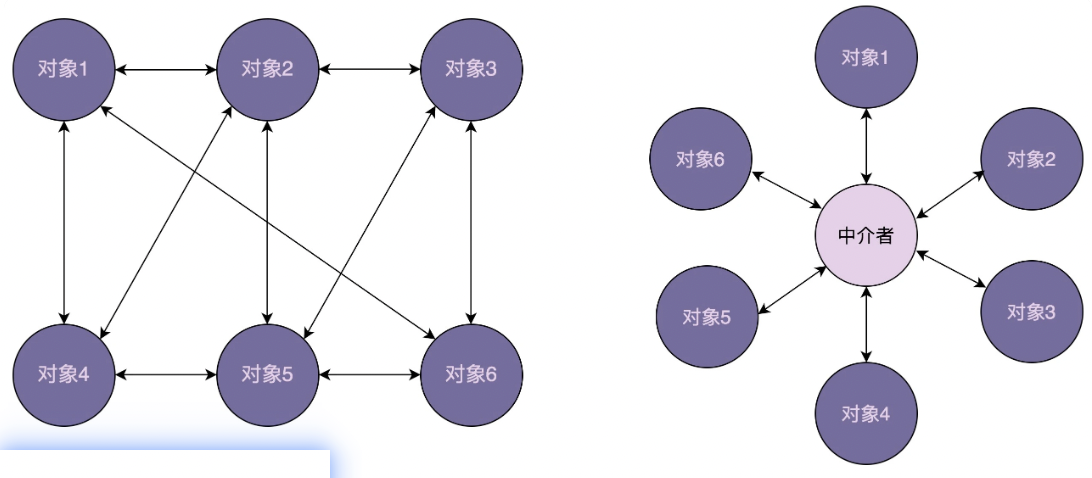中介模式的原理和实现 中介模式的英文翻译是 Mediator Design Pattern。在 GoF 中的《设计模式》一书中,它是这样定义的:
Mediator pattern defines a separate (mediator) object that encapsulates the interaction between a set of objects and the objects delegate their interaction to a mediator object instead of interacting with each other directly.
翻译成中文就是:中介模式定义了一个单独的(中介)对象,来封装一组对象之间的交互。将这组对象之间的交互委派给与中介对象交互,来避免对象之间的直接交互。
实际上,中介模式的设计思想跟中间层很像,通过引入中介这个中间层,将一组对象之间的交互关系(或者说依赖关系)从多对多(网状关系)转换为一对多(星状关系)。原来一个对象要跟 n 个对象交互,现在只需要跟一个中介对象交互,从而最小化对象之间的交互关系,降低了代码的复杂度,提高了代码的可读性和可维护性。
提到中介模式,有一个比较经典的例子不得不说,那就是航空管制。为了让飞机在飞行的时候互不干扰,每架飞机都需要知道其他飞机每时每刻的位置,这就需要时刻跟其他飞机通信。飞机通信形成的通信网络就会无比复杂。这个时候,我们通过引入“塔台”这样一个中介,让每架飞机只跟塔台来通信,发送自己的位
假设我们有一个比较复杂的对话框,对话框中有很多控件,比如按钮、文本框、下拉框等。当我们对某个控件进行操作的时候,其他控件会做出相应的反应,比如,我们在下拉框中选择“注册”,注册相关的控件就会显示在对话框中。如果我们在下拉框中选择“登陆”,登陆相关的控件就会显示在对话框中。
用中介模式来实现的代码如下:
1 2 3 4 5 6 7 8 9 10 11 12 13 14 15 16 17 18 19 20 21 22 23 24 25 26 27 28 29 30 31 32 33 34 35 36 37 38 39 40 41 42 43 44 45 46 47 48 49 50 51 52 53 54 55 56 57 58 59 60 61 62 63 64 65 66 67 68 69 70 71 72 73 74 75 76 77 78 79 80 81 82 83 84 public interface Mediator { void handleEvent (Component component, String event) ; } public class LandingPageDialog implements Mediator { private Button loginButton; private Button regButton; private Selection selection; private Input usernameInput; private Input passwordInput; private Input repeatedPswdInput; private Text hintText; @Override public void handleEvent (Component component, String event) { if (component.equals(loginButton)) { String username = usernameInput.text(); String password = passwordInput.text(); } else if (component.equals(regButton)) { } else if (component.equals(selection)) { String selectedItem = selection.select(); if (selectedItem.equals("login" )) { usernameInput.show(); passwordInput.show(); repeatedPswdInput.hide(); hintText.hide(); } else if (selectedItem.equals("register" )) { } } } } public class UIControl { private static final String LOGIN_BTN_ID = "login_btn" ; private static final String REG_BTN_ID = "reg_btn" ; private static final String USERNAME_INPUT_ID = "username_input" ; private static final String PASSWORD_INPUT_ID = "pswd_input" ; private static final String REPEATED_PASSWORD_INPUT_ID = "repeated_pswd_input" ; private static final String HINT_TEXT_ID = "hint_text" ; private static final String SELECTION_ID = "selection" ; public static void main (String[] args) { Button loginButton = (Button)findViewById(LOGIN_BTN_ID); Button regButton = (Button)findViewById(REG_BTN_ID); Input usernameInput = (Input)findViewById(USERNAME_INPUT_ID); Input passwordInput = (Input)findViewById(PASSWORD_INPUT_ID); Input repeatedPswdInput = (Input)findViewById(REPEATED_PASSWORD_INPUT_ID); Text hintText = (Text)findViewById(HINT_TEXT_ID); Selection selection = (Selection)findViewById(SELECTION_ID); Mediator dialog = new LandingPageDialog (); dialog.setLoginButton(loginButton); dialog.setRegButton(regButton); dialog.setUsernameInput(usernameInput); dialog.setPasswordInput(passwordInput); dialog.setRepeatedPswdInput(repeatedPswdInput); dialog.setHintText(hintText); dialog.setSelection(selection); loginButton.setOnClickListener(new OnClickListener () { @Override public void onClick (View v) { dialog.handleEvent(loginButton, "click" ); } }); regButton.setOnClickListener(new OnClickListener () { @Override public void onClick (View v) { dialog.handleEvent(regButton, "click" ); } }); } }
从代码中我们可以看出,原本业务逻辑会分散在各个控件中,现在都集中到了中介类中。实际上,这样做既有好处,也有坏处。好处是简化了控件之间的交互,坏处是中介类有可能会变成大而复杂的“上帝类”(God Class)。所以,在使用中介模式的时候,我们要根据实际的情况,平衡对象之间交互的复杂度和中介类本身的复杂度。
中介模式 VS 观察者模式 前面讲观察者模式的时候,我们讲到,观察者模式有多种实现方式。虽然经典的实现方式没法彻底解耦观察者和被观察者,观察者需要注册到被观察者中,被观察者状态更新需要调用观察者的 update() 方法。但是,在跨进程的实现方式中,我们可以利用消息队列实现彻底解耦,观察者和被观察者都只需要跟消息队列交互,观察者完全不知道被观察者的存在,被观察者也完全不知道观察者的存在。
中介模式也是为了解耦对象之间的交互,所有的参与者都只与中介进行交互。而观察者模式中的消息队列,就有点类似中介模式中的“中介”,观察者模式的中观察者和被观察者,就有点类似中介模式中的“参与者”。那问题来了:中介模式和观察者模式的区别在哪里呢?什么时候选择使用中介模式?什么时候选择使用观察者模式呢?
在观察者模式中,尽管一个参与者既可以是观察者,同时也可以是被观察者,但是,大部分情况下,交互关系往往都是单向的,一个参与者要么是观察者,要么是被观察者,不会兼具两种身份。也就是说,在观察者模式的应用场景中,参与者之间的交互关系比较有条理。
而中介模式正好相反。只有当参与者之间的交互关系错综复杂,维护成本很高的时候,我们才考虑使用中介模式。毕竟,中介模式的应用会带来一定的副作用,前面也讲到,它有可能会产生大而复杂的上帝类。除此之外,如果一个参与者状态的改变,其他参与者执行的操作有一定先后顺序的要求,这个时候,中介模式就可以利用中介类,通过先后调用不同参与者的方法,来实现顺序的控制,而观察者模式是无法实现这样的顺序要求的。
